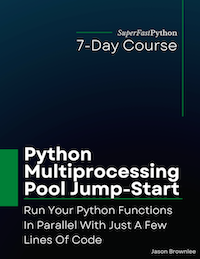You can share a queue with workers in the pool using the fork start method and inheritance of global variables or by sharing proxy objects for a queue …
Continue Reading about How to Share a Queue with a Multiprocessing Pool →
Tutorials on the Multiprocessing Pool class for concurrency in Python.
You can share a queue with workers in the pool using the fork start method and inheritance of global variables or by sharing proxy objects for a queue …
Continue Reading about How to Share a Queue with a Multiprocessing Pool →
You can execute functions, methods, and static methods as tasks in the multiprocessing pool. Some other types of functions, such as lambda …
Continue Reading about Multiprocessing Pool with Different Function Types →
The Python Multiprocessing Pool provides reusable worker processes in Python. The Pool is a lesser-known class that is a part of the Python …
Continue Reading about Python Multiprocessing Pool: The Complete Guide →
You can achieve full parallelism in Python with the multiprocessing pool, side-stepping the GIL. In this tutorial you will discover the …
Continue Reading about Multiprocessing Pool and the Global Interpreter Lock (GIL) →
Child worker processes in the multiprocessing pool will be restarted automatically if killed. In this tutorial you will discover what happens if a …
Continue Reading about Multiprocessing Pool Restarts Workers if Killed →
Child worker processes are started automatically after creating an instance of the multiprocessing.Pool class. In this tutorial you will discover …
Continue Reading about Multiprocessing Pool When Are Workers Started →
The multiprocessing pool will be closed automatically by the Python garbage collector, if required. It will not prevent the main process from …
Continue Reading about Does the Multiprocessing Pool Stop Main From Exiting →
You can read the PEP for the multiprocessing module and Python release changelogs in order to learn the history of the multiprocessing pool. In …
Continue Reading about Multiprocessing Pool PEP and History →
You can execute tasks in batches using the “chunksize” argument when using the Pool map() method. In this tutorial you will discover the chunksize …
Continue Reading about How to Configure Multiprocessing Pool.map() Chunksize →

What if you could use all of the CPU cores in your system right now, with just a very small change to your code?
The Multiprocessing Pool class provides easy-to-use process-based concurrency.
There's just one problem. Few people know about it (or how to use it well).
Introducing: "Python Multiprocessing Pool Jump-Start".
A new book designed to teach you multiprocessing pools in Python step-by-step, super fast!
